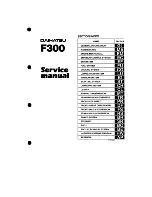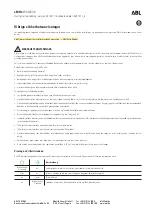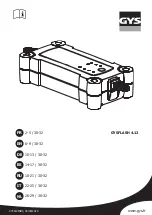
8-1
ELECTRICAL SYSTEM
ELECTRICAL SYSTEM
12v POWER SUPPLY
Battery Installation
Your motorhome will be fitted with a BCA
Leisure charging and power distribution unit.
If you wish to install a leisure battery please
ensure that it is placed on the battery tray
supplied with your motorhome. Then place the
tray in the battery locker fitted to the side of
your motorhome. Connect the battery to the
clamp fittings connected to the connection leads
within the battery box.
The Explorer Group recommends that you use
sealed for life leisure batteries of a minimum
rating off 40 ampere-hours at 20 hours discharge
rate.
Battery Maintenance
Your leisure battery should be maintained in
accordance with the manufacturer’s instructions.
For information on the automatic charging
system in your motorhome please refer to
‘Automatic Charging System’ in the index.
Do not charge your leisure battery with any
charger other than that supplied. Failure to
comply may cause damage to your battery. If you
remove your leisure battery, ensure that it is not
placed on a cold surface as the battery will
deteriorate more rapidly than if stored at a
suitable temperature
Generators / Charger
All electrical equipment fitted in your new
motorhome can be run from either a controlled
generator or charger whose output is maintained
between 11volts and 14volts.
At least once every 3 years, the motorhome
electrical installation should be inspected and
tested, and a report on its condition obtained, as
prescribed in British Standard BS7671.
230v POWER SUPPLY
Mains Unit
The Mains Unit replaces the conventional fuse
box. Similar, but larger ones are often fitted in
new houses. The unit, normally located in the
wardrobe, gives overloads and earth leakage
protection for the 230V electrical supply in your
motorhome.
For normal operation all switches on the unit
need to be in the ON position. The switches on
the left of the unit are known as MCB’s
(miniature circuit breakers). These take the place
of the conventional fuse but are more convenient.
In the event of a fault the MCB ‘trips’ i.e.
automatically moves to the OFF position. After
elimination of the fault the MCB can be re-set by
switching to the ON position (against the spring
pressure in an upwards direction). If an earth fault
develops, or a person was to touch a live piece of
equipment, the leakage of current to earth should
immediately operate the RCD (residual current
device) and ‘trip’ the main switch, to the OFF
position. This switch can only be re-set after
elimination of the fault.
Please Note:
In case of difficulty, consult an
approved electrical installation contractor (who
may be the local electricity board). It is dangerous
to attempt modifications and additions yourself.
Caution:
Lamp holder-plugs (bayonet- cap
adaptors) should not be used under any
circumstances.
Resetting the RCD
To re-set, operate the switch as for MCB’s.
Periodically, the RCD should be checked by
operating the test button marked ‘T’. The unit
should immediately switch to the OFF position. If
the unit does not switch off then a qualified
electrician should be consulted. If the unit does
switch off, the test is complete and the switch can
be re-set restoring the supply back to normal.
Please Note:
Simultaneous operation of all of
the 230V mains electrical equipment may not be
possible. A typical UK site mains hook-up point
provides a maximum output of 16 amps and on
some continental sites the available output may
be as low as 5 amps. If your loading exceeds the
site supply it may trip the site circuit breaker.
Please check the available mains output with your
site operator. The following items need to be
added together if used simultaneously.
230V mains equipment typical consumption
figures:
• Refrigerator ............................................ 0.50 amps
• Charger .................................................... 0.50 amps
• Water heater ............................................ 3.9 amps
• Blown air heaters .................................... 8.5 amps
• Colour TV ............................................... 3.33 amps
Summary of Contents for AUTOQUEST 115 2012
Page 5: ...1 2 INTRODUCTION ...
Page 11: ...4 2 MOTORWAY HANDLING ...
Page 13: ...5 2 ARRIVING ON SITE ...
Page 19: ...6 6 GETTING STARTED ...
Page 21: ...7 2 GAS SAFETY ADVICE ...
Page 24: ...8 3 ELECTRICAL SYSTEM 12V FUSES AUTOQUEST ...
Page 25: ...8 4 ELECTRICAL SYSTEM MAINS UNIT AUTOQUEST ...
Page 50: ...9 25 HOWTO USEYOUR MOTORHOME S EQUIPMENT ...
Page 63: ...11 6 CARE OFYOUR MOTORHOME ...
Page 65: ...12 2 STORAGE ...
Page 69: ...13 4 WARRANTY ...
Page 71: ...14 2 CODE OF PRACTICE ...
Page 73: ...15 2 MOTORHOME CONSTRUCTION ...
Page 75: ...16 2 EQUIPMENT LIST ...
Page 76: ...17 1 ELECTRICAL DRAWINGS ELECTRICAL DRAWINGS AUTOQUEST ...
Page 77: ...17 2 ELECTRICAL DRAWINGS ...
Page 83: ...19 4 GLOSSARY ...
Page 87: ...20 4 SERVICE DOCUMENTS ...
Page 89: ...21 2 CHANGE OF OWNERSHIP ...
Page 91: ...22 2 CHANGE OF ADDRESS ...
















































